Monorail - the answer to Colombo's traffic congestion
Feasibility studies to connect Fort and Malabe at
final stage:
By Ranil Wijayapala
 The opening of the southern , Katunayake, and the outer circular
expressway has given an opportunity for the people living outside
Colombo city to seriously think about their future when planning on
their future residencies. They may have to decide between investing
their money to build a house in their home town or to purchase a land
close to Colombo. The opening of the southern , Katunayake, and the outer circular
expressway has given an opportunity for the people living outside
Colombo city to seriously think about their future when planning on
their future residencies. They may have to decide between investing
their money to build a house in their home town or to purchase a land
close to Colombo.
There were times when people thought living close to Colombo was a
major advantage, after considering their workplaces in Colombo city
limits and considering the education of children in Colombo centered
schools and other educational institutions.
With the new developments in the transportation sector, and the
opening of expressways, people tend to move away from the Colombo city
as well as from Colombo suburbs as travelling in the congested city
roads has become a daily nuisance compared to travelling from
outstations using train services.
Ironically, while people from Panadura, Kalutara, Gampaha and
Aluthgama reach their hometowns from Colombo by train within one hour,
those living closer to Colombo (in areas such as Battaramulla, Malabe
and Athurugiriya) have to spend more time to reach their destination
from Colombo.
Office workers find those living in Ambalangoda, Galle, Polgahawela,
Alawwa reach home by train much quicker than the fellow workers living
in Battaramulla, Malabe , Kaduwela, Piliyandala, Kesbewa or Homagama.
Moreover, with the opening of the Katunayake expressway people in
Jaela, Negombo, or Chilaw have also got the opportunity to reach their
destination faster than earlier with the commencement of the bus
services on the expressway. Therefore, people who opted to live in
boarding houses in Colombo to attend office and studies have reverted to
travel from their home towns.
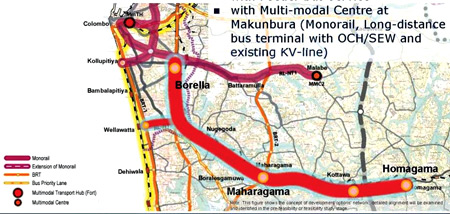
Adding to this situation people living in Galle and Matara also get
an opportunity to reach their southern towns in less than one and half
hours after entering the expressway either from Kaduwela or Kottawa.
This has made travelling much easier for them. But when it comes to
travelling to the centre of Colombo city from these transit points the
situation becomes worse as the increasing number of vehicles create a
huge traffic congestion in the Colombo city and its suburbs.
Although a person from Matara can reach Kottawa within one and half
hours people have to spend an equal time to reach Colombo city along the
High Level Road or from Kaduwela side along Malabe - Battaramulla Road.
Speedy access
Therefore, there is a need to find solution for the people to have a
speedy access to the Colombo city from using public transportation
systems.
To overcome this problem, the Ministry of Transport has embarked on a
project to launch the Urban Transport Development Project for Colombo
Metropolitan Region and Suburbs under a grant assistance from the
Japanese International Cooperation Agency (JICA).
According to Additional Secretary Planning of the Ministry of
Transport J.M. Thilakarathna Banda, the study was started in May 2012
after JICA gave a grant for a comprehensive study to reduce the traffic
congestion in the Colombo Metropolitan area and suburbs as it has become
a serious issue impeding the rapid development process taking place in
the Colombo city limits in terms of man hours lost per day.
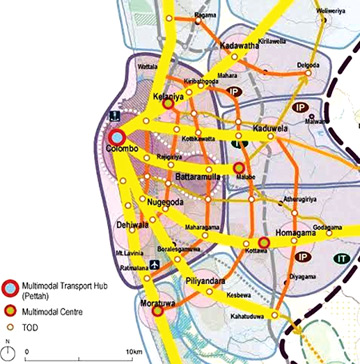 "Shaping the future of the urban transport system by promoting the
public transport system in Colombo metropolitan area was the vision of
this study", he said. "Shaping the future of the urban transport system by promoting the
public transport system in Colombo metropolitan area was the vision of
this study", he said.
This study also aimed at adopting an overall planning strategy of
having integrated urban development within an urban transport system,
introducing a new public transport system, introducing user friendly
transit facilities for existing public transport and to increase road
capacity and optimise its use.
"The study also aimed at addressing the transport issues within the
Colombo Metropolitan region considering its future expansions upto year
2035", he said.
The project was aimed at conducting a comprehensive study on the
transport system in the metro Colombo area and to identify the solutions
to address the transport issues till 2035. The study is now at its final
stage and we are more focusing on identifying the solutions for the
major traffic issues.
The study was conducted by a team of Japanese from the JICA along
with a team of transport experts from Sri Lanka.
The number of vehicles entering the Colombo city from different
directions were identified and people were interviewed to identify their
transport requirements and the origin and end of their journeys.
Under this study they have identified seven corridors from which
vehicles are entering the Colombo city. Galle, Horana, Negombo, Kandy,
Low Level, High Level and Malabe corridors were identified and it has
been estimated that over one million people are entering the Colombo
city through these seven corridors. The highest number of people -
174,000 - are reported from Galle Road and the second highest of 157,000
persons enter the city via Malabe corridor.
"To address the issues relating to each corridor, different solutions
have been identified through this study," he said.
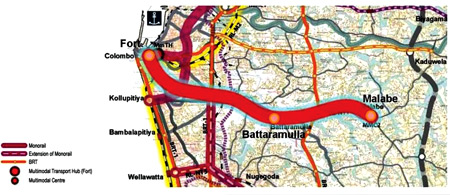 For instance, to reduce the congestion on the Negombo corridor, it
has been identified to improve the Puttalam railway line and to
introduce a bus priority lane on the Negombo Road. Bus Priority System
has been identified for the traffic congestion on the Low Level Road
through this study. For instance, to reduce the congestion on the Negombo corridor, it
has been identified to improve the Puttalam railway line and to
introduce a bus priority lane on the Negombo Road. Bus Priority System
has been identified for the traffic congestion on the Low Level Road
through this study.
"To address the traffic issues on Kandy corridor also they have
identified Bus Rapid Transport system upto Kiribathgoda and to modernise
the Main Railway Line", he said.
To reduce the traffic congestion on the High Level Road the study has
identified a mono rail system from Borella to Homagama while
recommending to modernising the coast railway line and introducing Bus
Rapid Transport System as a solution for the Galle corridor.
"As a solution for the Malabe corridor which is having the highest
number of private vehicles, a mono rail system has been identified as a
solution for the traffic congestion along the Battaramulla - Malabe
corridor," Thilakarathna Banda said.
Since the study also aimed at conducting a feasibility study for a
new transport mode, feasibility studies are now being conducted for the
monorail system to address the issue of traffic congestion specially for
the Malabe corridor.
"Monorail system has been identified as a solution for the Malabe
corridor as the biggest number of private vehicles are entering the
Colombo city from Malabe - Battaramulla - Rajagiriya corridor.
This is a possible solution for this section as the Government has
decided to shift all the government Ministries and institutions to
Battaramulla and the Military Headquarters to Pelawatta area", he said.
"Introduction of the monorail system will be an effective way to
cater to the increasing demand for transportation in Battaramaulla area
and also to reduce the number of private vehicles using the road", he
said.
"Monorail is also feasible for this corridor as it requires minimum
land acquisition. As a trace have been identified through a marshy and
uncultivable lands from the Sethsiripaya to the Thalahena trace", he
said. "Although the monorail has been proposed upto Kaduwela, the first
phase will focus only upto Malabe", he said.
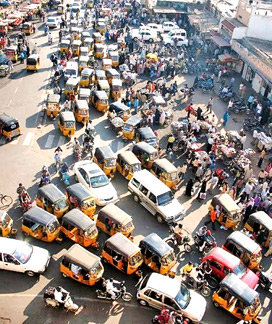 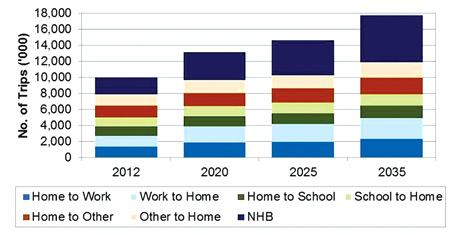 Feasibility studies are now being done to extend this monorail
service upto Kotahena via Colombo Fort and then to Kelaniya via
Mattakkuliya. Feasibility studies are now being done to extend this monorail
service upto Kotahena via Colombo Fort and then to Kelaniya via
Mattakkuliya.
However, the final decision whether to introduce the monorail system
as a solution for the congested roads will be taken by the Government
after considering the final report of the study due in two months.
"The decision to implement this project will be decided on the basis
of availability of funding sources and the affordability for the public
to use this transport system to the masses. However if we can reduce the
number of vehicles coming into the city through the introduction of this
monorail system that will have major impact on reducing the congestion
on roads", he said.
"This type of transport development is required in the Colombo city
parallel to the rapid development taking place in the city at present.
If we cannot match the transport facilities with the city
beautification and development project that will impede the development
process in the city", he said.
To make these transport modes more efficient there should be a
central transport hub in the Colombo city and the study aims at
developing a central transport hub connecting all the bus stands and the
railway stations including the proposed monorail station, he said.
"Therefore, we are aiming to have a central transport hub using the
land at the Manning market , shifting the market to Peliyagoda very
soon.
The feasibility study is also focusing on having a central transport
hub in the Pettah by bringing all the bus terminals scattered in Pettah
to one place, and providing a better access for the transport hub", he
said.
"With the finalising of the study report and the feasibility study,
the Government will take a decision to implement whatever the possible
measures to streamline the traffic along the city streets and to develop
a new transport mode such as monorail system to make the public
transport system more efficient on a short term, medium term and long
term basis", he said. |

